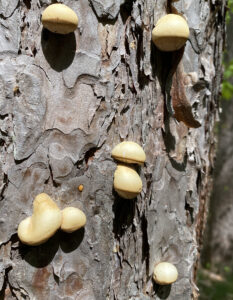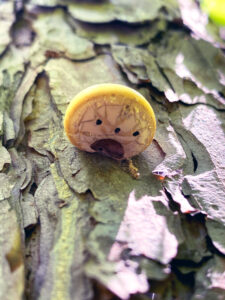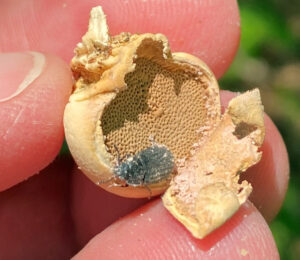
Veiled polypore fungi show as yellow, leathery fruiting bodies on the bark of dead red pine trees. / Photo Credit: Linda Williams, Wisconsin DNR
By Linda Williams, Forest Health Specialist
Linda.Williams@wisconsin.gov or 920-360-0665
You may have seen these leathery, yellow fungi growing on recently dead red pine trees and wondered if they were what killed the tree. The short answer: No, they did not kill the tree.
The veiled polypore (Cryptoporus volvatus) is a decay fungus that grows on the bark of red pine in the year after they die. They can be found anywhere on the trunk of the tree.

A hole on the underside of the veiled polypore fungus opens into a cavity where spores are released. / Photo Credit: Linda Williams, Wisconsin DNR
The unique thing about this fungus is that there is a hole on the bottom of the fruiting body that opens into a small cavity. Spores are produced and released inside this cavity, and some wood-boring beetles love to hide in there and feed on the fungus. Beetles become dusted in spores and can then carry them to another recently dead red pine.
This decay fungus causes white, punky decay in the first inch of wood under the bark. It’s one of the first decay fungi to invade recently dead trees and does not remain on the trees for long.
In Wisconsin, this fungus is most common on red pine, but literature indicates it could also grow on balsam fir, hemlock and tamarack. Since this is a decay fungus that does not actively kill the tree, there is no need to control or eliminate these fungi when you see them.

Opening the bottom of the veiled polypore’s fruiting body exposes the porous, spore-producing surface, as well as a beetle that was in the cavity to feed on the fungus. / Photo Credit: Linda Williams, Wisconsin DNR
